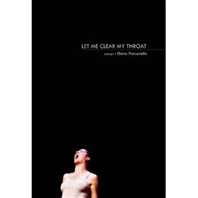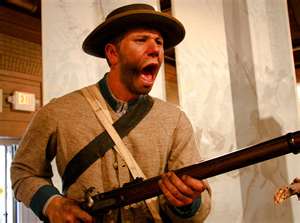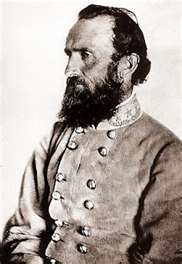 I can’t quite get the Rebel Yell (the warcry, not the Kentucky bourbon) off my mind today because last night in the quiet and lamplight I read the essay “How to Spell the Rebel Yell” from Elena Passarello’s new book Let Me Clear My Throat (Sarabande, 2012). Of course, I’m a pretty easy target, living as I do in the village where the Confederacy is buried, sort of. Lexington VA houses, in W & L’s Lee Chapel, the remains of Robert E. Lee (and almost every other Lee but Anabelle). And Stonewall Jackson, whom Passarello cites as a possible source of the battlescream, is buried in the town’s (surprise!) Stonewall Jackson Cemetery. Since childhood hours with Bruce Catton’s and Douglas Southall Freeman’s books (and Foote’s, among other, since), I’ve wondered if that chorus of banshee-wildcat-muleskinner yodelscreams really could curdle blood, and how much was from terror, how much to terrorize.
I can’t quite get the Rebel Yell (the warcry, not the Kentucky bourbon) off my mind today because last night in the quiet and lamplight I read the essay “How to Spell the Rebel Yell” from Elena Passarello’s new book Let Me Clear My Throat (Sarabande, 2012). Of course, I’m a pretty easy target, living as I do in the village where the Confederacy is buried, sort of. Lexington VA houses, in W & L’s Lee Chapel, the remains of Robert E. Lee (and almost every other Lee but Anabelle). And Stonewall Jackson, whom Passarello cites as a possible source of the battlescream, is buried in the town’s (surprise!) Stonewall Jackson Cemetery. Since childhood hours with Bruce Catton’s and Douglas Southall Freeman’s books (and Foote’s, among other, since), I’ve wondered if that chorus of banshee-wildcat-muleskinner yodelscreams really could curdle blood, and how much was from terror, how much to terrorize.
 Passarello has wondered about it a lot harder than I ever did, and she’s searched the records of the day, mustering the various descriptions — historical, literary, hypothetical — towards a narrative that eschews (a word I will not say aloud, as it sounds like the antithesis of the yell) certainty in favor of lively possibilities.
Passarello has wondered about it a lot harder than I ever did, and she’s searched the records of the day, mustering the various descriptions — historical, literary, hypothetical — towards a narrative that eschews (a word I will not say aloud, as it sounds like the antithesis of the yell) certainty in favor of lively possibilities.
Did Jackson tell his men at Manassas to “yell like furies,” and if so was he asking for a wilder and less sane cheer than the clearly martial and organized “Huzzah!” he’d learned at West Point? This is one of Passarello’s points of departure. She cites the writings of British and American ear-witnesses at Manassas and Arthur Freemantle, who heard it on more than one occasion as he studied and wrote about the war. I’m particularly taken by her notions that it might have been like the outcry in the original word scramble at Babel and that it’s meant to make the foe wonder, “How does a body go about attacking a bunch of freaks like these?”
The plot thickens when our astute narrator starts looking at the ways people have spelled the yell for both literary and archival purposes. In the end, she cites James Weldon John’s effiorts in his novel Autobiography of an Ex-Colored Man and concludes that “a sound which induces terror is a sound which cannot be mapped.”
And she can’t resist a quick survey of what other ethnicities and cultures shout or chant on the edge of bloodletting. It’s a peculiar list, but nobody else seems to have a yell that sounds like Hell. Maybe Wilfred Owen would have described it as like the voice of “a devil sick of sin.”
 For Stonewall the sound was “sweet,” for Ambrose Bierce it was “ugly,” but the uncontested truth is that Passarelle’s own writing is carefully pitched and modulated, hypnotic and surprising, musical, erudite without being prissy, reader-friendly even when it challenges preconceptions. I can’t wait to sit down and hear the whole collection this weekend, maybe even croon and yawp along.
For Stonewall the sound was “sweet,” for Ambrose Bierce it was “ugly,” but the uncontested truth is that Passarelle’s own writing is carefully pitched and modulated, hypnotic and surprising, musical, erudite without being prissy, reader-friendly even when it challenges preconceptions. I can’t wait to sit down and hear the whole collection this weekend, maybe even croon and yawp along.
P.S. Passarella was the first woman to win the annual Stella Screaming Contest in New Orleans. She’s not all theory.

